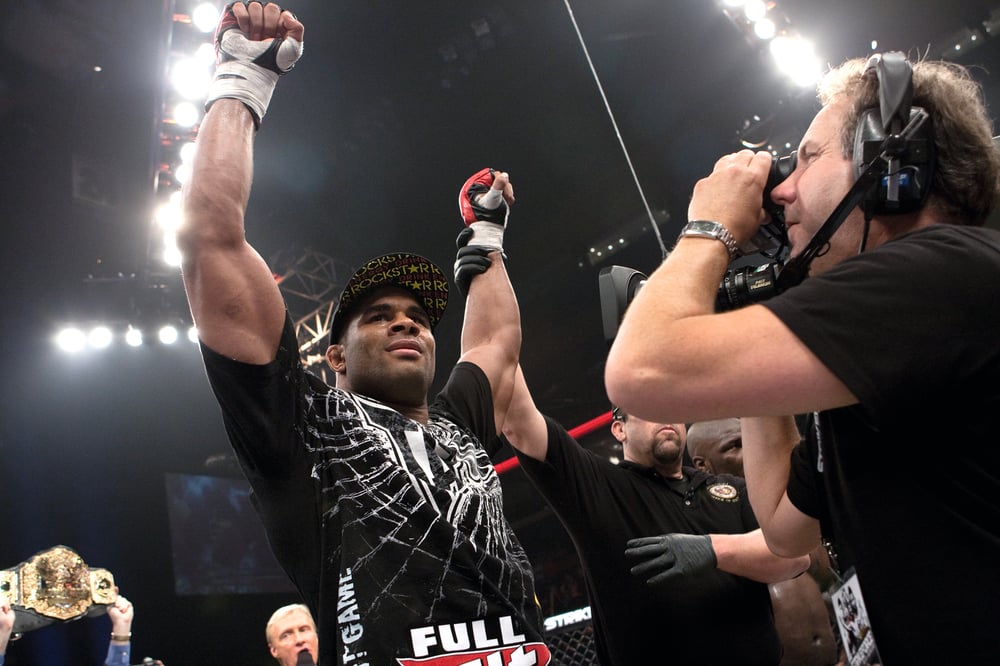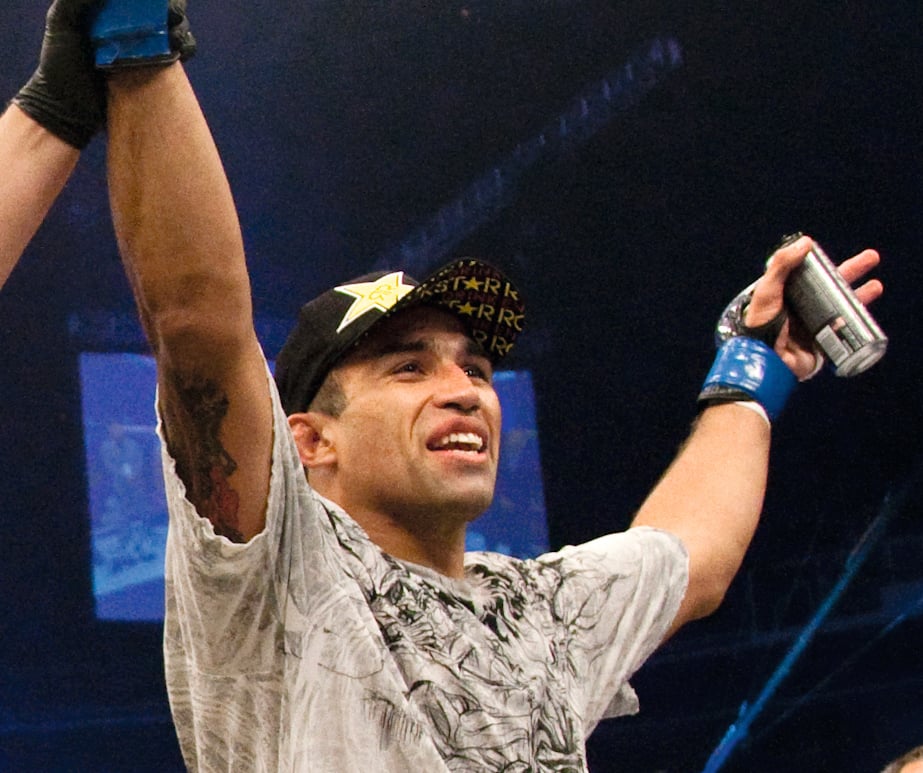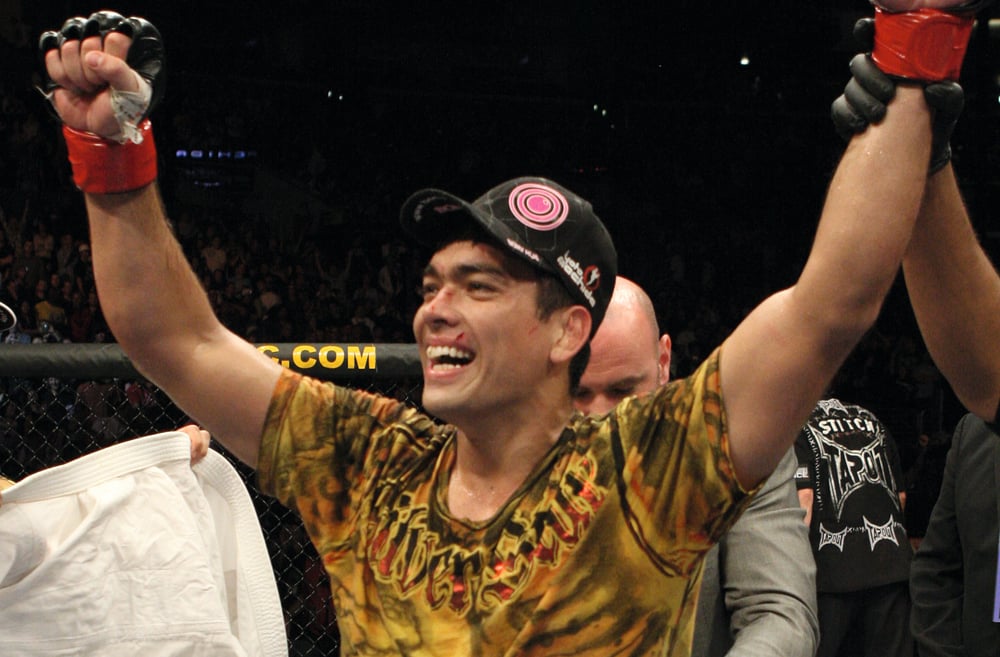
Issue 074
April 2011
FO’s experts and statisticians analyze three upcoming bouts
First, FO analyst Andrew Garvey takes a look at the state of play: what are the career implications for the combatants? Where are they coming from, and what will victory or defeat hold? Next, our technical editor Pete Irving breaks down the athletic considerations.
Georges St Pierre vs Jake Shields
UFC 129, April 30, 2011, Toronto, Canada
Georges St Pierre 21-2-0 Vs Jake Shields 26-4-1
Shields has 13 decision wins, five more than GSP or any of the latter’s previous title challengers
Despite having 54 fights between them, Shields and St Pierre only have one common opponent in MMA competition: Jason ‘Mayhem’ Miller. Miller lost via unanimous decision to both men
In five years and 13 fights Shields’ opponents have only advanced position on the mat six times compared to his 91
St Pierre has avoided a staggering 86% of takedowns in a UFC career that has seen him square off with noted wrestlers Matt Hughes, Jon Fitch and Josh Koscheck
Against wrestler Dan Henderson, Shields secured four of 11 takedown attempts
THE BIGGER PICTURE
When Dana White whipped out-of-contract Strikeforce middleweight champion Shields (26-4-1) from under SF promoter Scott Coker’s nose, it seemed like a major coup and a serious blow to the rival promotion. A few minutes into Shields’ UFC debut and the incident was starting to look as if Coker had masterfully offloaded a pricey pig-in-a-poke with a habit of subduing TV audiences and live crowds alike. With a long record of success at welterweight, Shields was signed as a future challenger for Georges St-Pierre (21-2) but, struggling to make 170lb for the first time since late 2008, Shields was fortunate to get the UFC 121 judges' verdict over Martin Kampmann. Still, one iffy performance shouldn’t obscure the 32-year-old’s six-year, fifteen-fight winning streak where he’s beaten Carlos Condit, Paul Daley, Robbie Lawler and Dan Henderson. Not bad for a fighter with below-par striking and, in an odd sort of a way, his success shows what an exceptional wrestler and dangerous submission artist he is. And don’t forget Shields’ resilience: Henderson almost knocked him into another time zone yet Shields survived, came back and dominated the next four rounds to win a decision. But no matter how good Shields is – and, Kampmann fight aside, how worthy a challenger he is too – he’ll be a huge underdog in Toronto.
Voted the Rogers Sportsnet Canadian Athlete of the Year for the last three years, St Pierre was the only man for the job of headlining the UFC’s much-awaited Toronto debut. Beloved in his home country like no other MMA fighter in the world, GSP will help pull the largest paying crowd in North American MMA history (K-1 Dynamite! at the LA Coliseum let many people in for free). And if all goes to plan, he’ll lay waste to a challenger who, put bluntly, isn’t good enough to beat him. That’s not meant as a criticism of Shields either. Which other welterweight can realistically expect to beat the peerless 170lb king? In his last eight fights, GSP has lost precisely one round, to Josh Koscheck, in 2007. In their rematch, St Pierre took not just every round, but almost every second of the fight, memorably jabbing Koscheck’s right eye into an ugly mess in a performance as tightly controlled and near-flawless on his feet as his wrestling-based dominations of Dan Hardy and Thiago Alves. Barring an astounding surprise, St Pierre will retain his belt for the sixth straight time, and do so in style. Will GSP dispatch Shields inside a couple of rounds and answer all those critics who sneer at his recent inability to finish a fight? Shields hasn’t been finished in over a decade, but GSP will be itching to seal a deal.
TECHNICAL BREAKDOWN
Shields' stand-up is stiff and awkward looking. Upright, slow, plodding footwork, no head movement and all combined with unwieldy single shots – it seems unfathomable that Shields could catch GSP with any telling blows. St Pierre on the other hand, whilst not the division’s biggest hitter, has superb in-out footwork and a vast bag of tricks to draw on, like his trademark superman jab to leg-kick combos. St Pierre is unpredictable, deceptive and insightful with his movement and combinations – all the things that Shields is not.
Shields and GSP both stick to a basic wrestling vocabulary of double-leg, single-leg and body-lock sag takedowns. The difference lies in GSP’s superior timing and explosive finishing. Shields relies on his opposition over committing or planting their feet to make his entry, or finds himself embroiled in an ugly chase after their legs. St Pierre is unlikely to make the mistake of staying static within Shields’ range. And without an explosive capacity to cover distance, like Josh Koscheck has, Shields will struggle to set up the shot.
The only area in which Shields outstrips the champion is pure jiu-jitsu. In terms of submission wrestling, only the cream of the world’s elite grapplers, like Marcelo Garcia, can outdo Shields. Shields’ brand of ‘American jiu-jitsu’ is nothing flashy – just methodical, basic techniques executed perfectly to smother and control his opposition from the top. Unsurprisingly, ten of Shields’ stoppage victories have been by way of submission, with only three by TKO. Shields’ positional control may be superb, but so far his ground ‘n’ pound has been underwhelming. Shields is essentially an arm-puncher who doesn’t put his full body into strikes. In spite of throwing a large volume of punches once he’s achieved mount, he inflicts surprisingly little damage with his fists. A jiu-jitsu black belt in his own right, St Pierre may not have quite the same grappling credentials as Shields but his adaptation for the Octagon is certainly more complete. St Pierre’s blending of ground ‘n’ pound with his passing, pinning and submission attacks is seamless. He harasses his opponents with small shots to set up his passes or land big, powerful blows.
Both men have histories of drawing out dominating decision victories against top flight opposition. Shields generally follows the pattern of struggling on the outside, then securing his takedown to dominate the match; GSP comes to each fight, and indeed each round, with a fresh, well drilled and uniquely tailored strategy that picks on the individual weaknesses of his opponent.

Alistair Overeem 34-11-(1NC) Vs Fabricio Werdum 14-4-1
Fabricio Werdum has submitted 42% of his 19 opponents, while Alistair Overeem has scored submission finishes in 41% of his 46 fights
During their 2006 meeting, Werdum scored one more strike in total than Overeem, but the Dutchman landed 14 more ‘significant’ shots
While Werdum eventually got the tap back then, Overeem got four of six takedowns while Werdum only managed 25% of his four attempts
Once known as ground-based, Overeem is the first and only fighter to win kickboxing’s K-1 World Grand Prix while active in mixed martial arts
Since losing to Werdum, Overeem has won 68%.of his bouts
Alistair Overeem vs Fabricio Werdum
Strikeforce, April, day and venue TBA (at time of going to press)

THE BIGGER PICTURE
The last time these two met in May 2006 Werdum won by submission. Back then the 25-year-old Overeem was relatively lanky at 228lb and the fight came during a rough period when he lost six of 11 fights. Now cartoonishly muscular, ‘Ubereem’ is, like Werdum’s last victim, surrounded by immense hyperbole based largely on him dominating a succession of middling talents (see Brett Rogers) and yesterday’s news (like Mark Hunt). Overeem (34-11-1NC) has recently been collecting title belts like old ladies hoard thimbles. The reigning Strikeforce heavyweight champion (albeit with just one defense against Rogers since winning it in 2007) and interim Dream champion, he also won the 2010 K-1 World Grand Prix tournament. The only man to ever combine high level success in MMA with a K-1 title, Overeem is an exceptionally dangerous fighter, especially early in the fight when he overwhelms unwitting opponents. Werdum (14-4-1) shocked the sport last June with a 69-second armbar win over Fedor Emelianenko and, after starting his MMA career as little more than a very talented grappler, greatly improved his striking during a four fight (2-2) UFC stint in 2007-08. But Overeem’s kickboxing is in a different league. That should spell the difference in this, the most interesting fight in the Strikeforce grand prix first round. Whatever happens, we should all have a better idea of where Overeem really stands in the heavyweight division after this is over.
TECHNICAL BREAKDOWN
As one might expect from a K-1 champion, Overeem’s Muay Thai skill towers over the rest of the heavyweight division. When fighting MMA, Overeem adopts a slightly lower stance and is a little more active with his footwork, but essentially delivers the same goods: powerful clubbing punches, chopping kicks and savage knees to the body. Overeem applies the same intention to his ground game, kneeing his opponent’s ribs from side control and dropping elbows. The Dutchman is sometimes apt to leave a lot of space when performing the cross-body, potentially dangerous against a guard player of Werdum’s caliber. Overeem’s favored submission is his famous guillotine, but although the Dutchman has a host of submission victories to his credit, the Brazilian has the edge in pure jiu-jitsu skill. Unsurprisingly, Werdum’s striking took a major upturn following his move to Chute Boxe some years ago. He uses his lead left body kick well, generating respectable power. At his core though, Werdum is a jiu-jitsu fighter. In the wake of his triangle choke victory over Fedor Emelianenko, the man previously thought impervious to the submission, Werdum must be overwhelmingly confident in his guard. Expect Werdum to try to be intent on the ground. If the Brazilian is unable to secure his takedown or pressured too heavily by Overeem’s punching power, he may elect to pull guard, just as he did in their initial Pride clash.

Randy Couture vs Lyoto Machida
UFC 129, April 30, 2011, Toronto, Canada
THE BIGGER PICTURE
A few months ago it seemed like UFC Hall of Famer Couture, 47, a seemingly ageless wonder of the modern world, was finally heading into a well-earned retirement. The oldest man to ever win a UFC fight, Couture is on a three-fight winning streak, outworking the ever-frustrating Brandon Vera, choking out Mark Coleman at UFC 109: Relentless, and easily dispatching rotund boxer James Toney in a largely pointless exercise (in hindsight at least) at UFC 118. Now though Couture (19-10) faces a legitimately elite fighter, even if Machida’s (16-2) stock fell almost as far as BP’s in 2010. Wildly and over-excitedly hailed as the unhittable, unbeatable karate master when he won the UFC light heavyweight title with a clinically brutal KO of Rashad Evans, Lyoto’s short title reign was a disappointment to say the least. Handed a decision over Mauricio ‘Shogun’ Rua at UFC 104, Machida was flattened inside a round of their rematch seven months later. Then at UFC 123, Quinton Jackson sneaked past him on the scorecards in a fight where Machida spent far too much of his time prancing around out of range. ‘Shogun’ proved that pressuring Machida really can work, although you have to be exceptionally good to do it. Couture will likely try and use his wrestling and clinching, as he did against Vera, to bully Machida but that (probably the best option available) may not work out well for a man pushing 50 against this fast, accurate and hurtful striker.

TECHNICAL BREAKDOWN
Couture, despite being partly responsible for huge leaps in the evolution of MMA over his substantial career, still remains much the same proposition as ever. In spite of obvious improvements in his striking skill, his boxing is still below UFC standards, and his kicking is more or less nonexistent. Couture holds his hands high with palms open, ready to block or parry, and tends to work off his jab, with which he steps in while predictably leaning over to his right in anticipation of the counter shot; or he steps in behind a leading right looking to clinch up. Once Couture ties up high he does his best work; hooking and uppercutting with his dirty boxing style. Where Couture shines, just as he always did, is his superbly adapted style of wrestling with an extensive repertoire of twists, tosses and foot sweeps. Couture’s leg tackles are unlike the typical freestyle attacks which originate from a low elevation, but draw instead on the precise level changing of his Greco-Roman background, going just a little lower to capture the hips. Machida’s long, deep stance with his back foot rotated out, and flighty in-out footwork contrast sharply with Couture’s square hips and measured steps. Expect Machida to use his footwork to hit and evade, and Couture to attempt to initiate a classic battle of upper-body tie-ups and secure cage control.
Randy Couture 19-10-0 vs Lyoto Machida 16-2-0
In his UFC career, Lyoto Machida has avoided 62% of strikes, only three percent more than Randy Couture
Both Machida and Couture have 15 years of MMA training despite an age gap of the same length. They each started in 1996
Couture is the oldest UFC title holder ever. He won the UFC heavyweight belt in 2007 at 43 years and 255 days
If Randy were to beat Machida it would give him four wins in a row for the first time in ten years
Over half of all Randy Couture’s 29 fights have been for a UFC title










